Financial Performance Analysis Report for FNN6800 Module
VerifiedAdded on 2022/12/28
|10
|2545
|47
Report
AI Summary
This report comprehensively analyzes financial performance management, addressing key aspects such as activity-based costing (ABC), variance analysis, and budgeting methods. Question 1 explores the computation of total cost and profit per unit using both labor-hour absorption and ABC approaches, followed by a critical evaluation of the results and the benefits of ABC. It also examines the role of sensitivity analysis in managing uncertainties. Question 2 delves into variance analysis, including the calculation of material usage, mix, and yield variances, alongside a discussion of issues with current variance calculation and reporting systems. Finally, Question 3 focuses on budgeting, comparing and contrasting incremental and zero-based budgeting methods, highlighting their advantages and disadvantages. The report utilizes calculations, tables, and critical evaluations to provide a thorough understanding of financial performance management principles and their practical applications, offering valuable insights for students studying this subject.
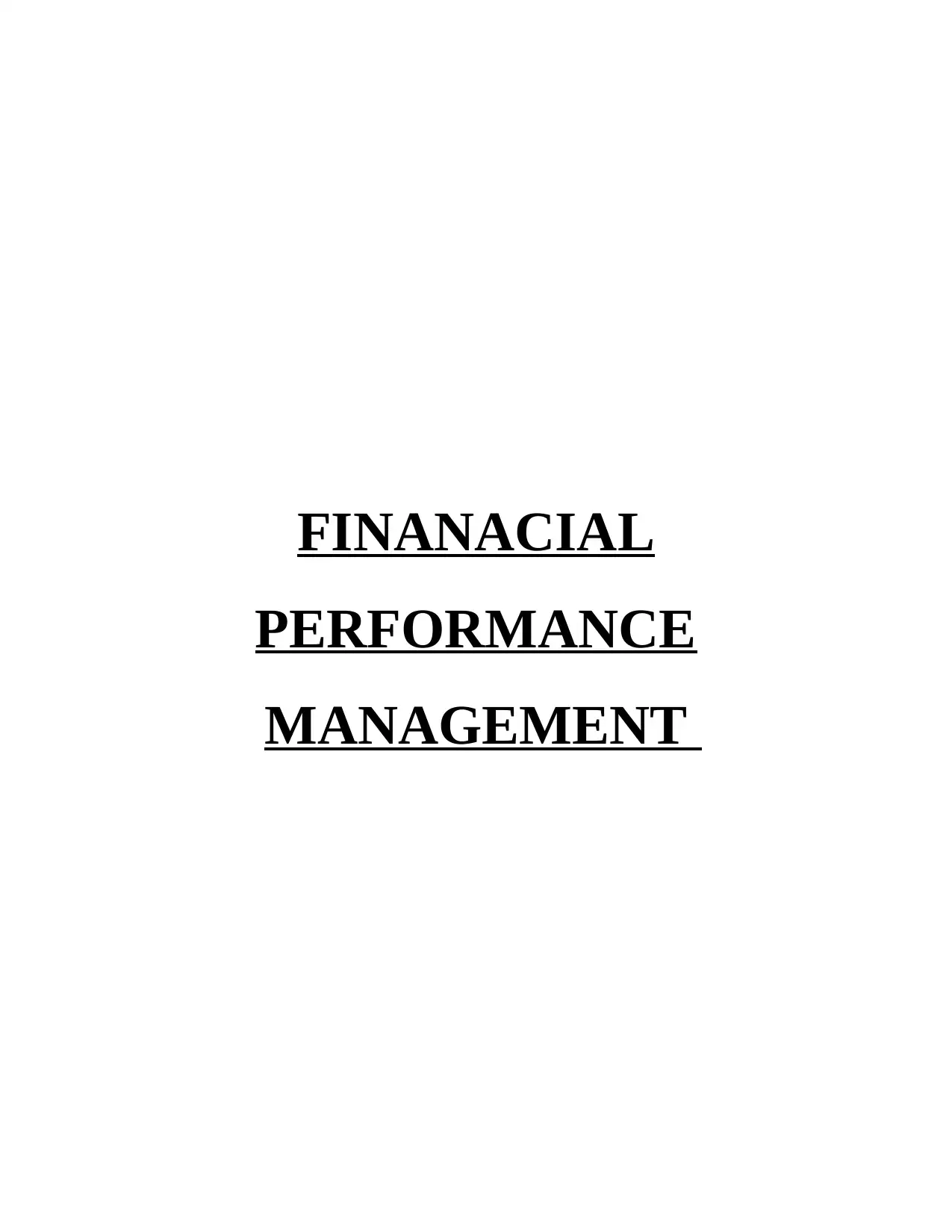
FINANACIAL
PERFORMANCE
MANAGEMENT
PERFORMANCE
MANAGEMENT
Paraphrase This Document
Need a fresh take? Get an instant paraphrase of this document with our AI Paraphraser
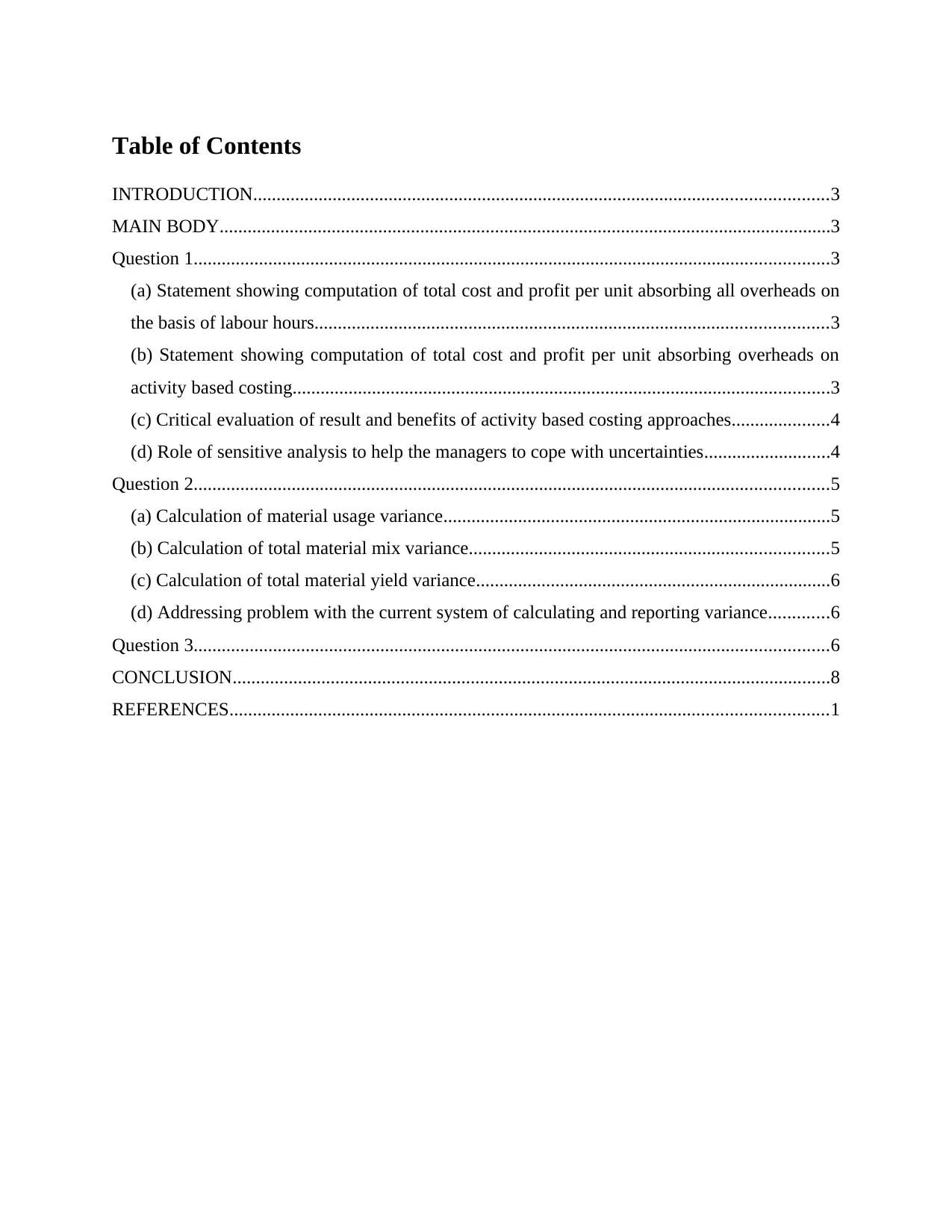
Table of Contents
INTRODUCTION...........................................................................................................................3
MAIN BODY...................................................................................................................................3
Question 1........................................................................................................................................3
(a) Statement showing computation of total cost and profit per unit absorbing all overheads on
the basis of labour hours..............................................................................................................3
(b) Statement showing computation of total cost and profit per unit absorbing overheads on
activity based costing...................................................................................................................3
(c) Critical evaluation of result and benefits of activity based costing approaches.....................4
(d) Role of sensitive analysis to help the managers to cope with uncertainties...........................4
Question 2........................................................................................................................................5
(a) Calculation of material usage variance...................................................................................5
(b) Calculation of total material mix variance.............................................................................5
(c) Calculation of total material yield variance............................................................................6
(d) Addressing problem with the current system of calculating and reporting variance.............6
Question 3........................................................................................................................................6
CONCLUSION................................................................................................................................8
REFERENCES................................................................................................................................1
INTRODUCTION...........................................................................................................................3
MAIN BODY...................................................................................................................................3
Question 1........................................................................................................................................3
(a) Statement showing computation of total cost and profit per unit absorbing all overheads on
the basis of labour hours..............................................................................................................3
(b) Statement showing computation of total cost and profit per unit absorbing overheads on
activity based costing...................................................................................................................3
(c) Critical evaluation of result and benefits of activity based costing approaches.....................4
(d) Role of sensitive analysis to help the managers to cope with uncertainties...........................4
Question 2........................................................................................................................................5
(a) Calculation of material usage variance...................................................................................5
(b) Calculation of total material mix variance.............................................................................5
(c) Calculation of total material yield variance............................................................................6
(d) Addressing problem with the current system of calculating and reporting variance.............6
Question 3........................................................................................................................................6
CONCLUSION................................................................................................................................8
REFERENCES................................................................................................................................1
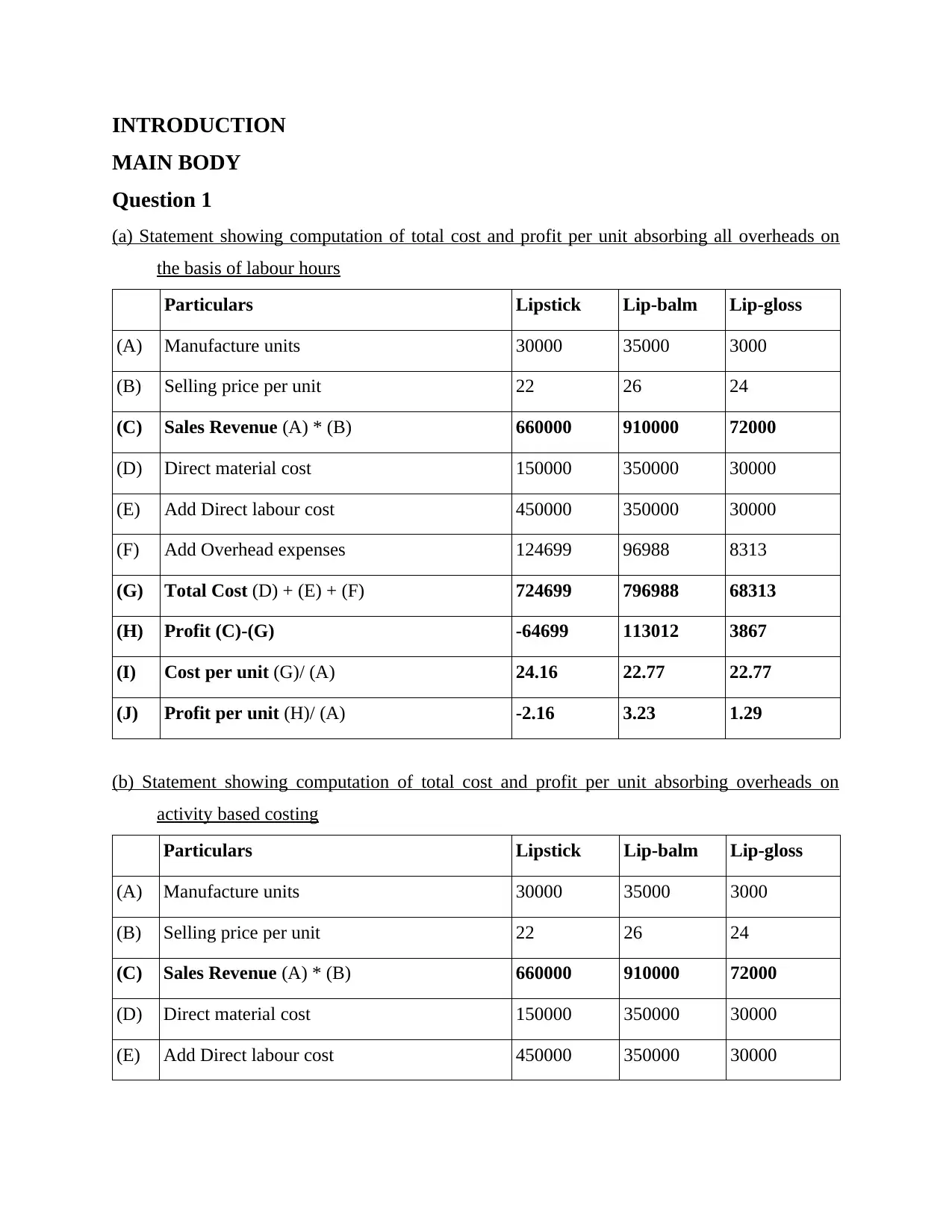
INTRODUCTION
MAIN BODY
Question 1
(a) Statement showing computation of total cost and profit per unit absorbing all overheads on
the basis of labour hours
Particulars Lipstick Lip-balm Lip-gloss
(A) Manufacture units 30000 35000 3000
(B) Selling price per unit 22 26 24
(C) Sales Revenue (A) * (B) 660000 910000 72000
(D) Direct material cost 150000 350000 30000
(E) Add Direct labour cost 450000 350000 30000
(F) Add Overhead expenses 124699 96988 8313
(G) Total Cost (D) + (E) + (F) 724699 796988 68313
(H) Profit (C)-(G) -64699 113012 3867
(I) Cost per unit (G)/ (A) 24.16 22.77 22.77
(J) Profit per unit (H)/ (A) -2.16 3.23 1.29
(b) Statement showing computation of total cost and profit per unit absorbing overheads on
activity based costing
Particulars Lipstick Lip-balm Lip-gloss
(A) Manufacture units 30000 35000 3000
(B) Selling price per unit 22 26 24
(C) Sales Revenue (A) * (B) 660000 910000 72000
(D) Direct material cost 150000 350000 30000
(E) Add Direct labour cost 450000 350000 30000
MAIN BODY
Question 1
(a) Statement showing computation of total cost and profit per unit absorbing all overheads on
the basis of labour hours
Particulars Lipstick Lip-balm Lip-gloss
(A) Manufacture units 30000 35000 3000
(B) Selling price per unit 22 26 24
(C) Sales Revenue (A) * (B) 660000 910000 72000
(D) Direct material cost 150000 350000 30000
(E) Add Direct labour cost 450000 350000 30000
(F) Add Overhead expenses 124699 96988 8313
(G) Total Cost (D) + (E) + (F) 724699 796988 68313
(H) Profit (C)-(G) -64699 113012 3867
(I) Cost per unit (G)/ (A) 24.16 22.77 22.77
(J) Profit per unit (H)/ (A) -2.16 3.23 1.29
(b) Statement showing computation of total cost and profit per unit absorbing overheads on
activity based costing
Particulars Lipstick Lip-balm Lip-gloss
(A) Manufacture units 30000 35000 3000
(B) Selling price per unit 22 26 24
(C) Sales Revenue (A) * (B) 660000 910000 72000
(D) Direct material cost 150000 350000 30000
(E) Add Direct labour cost 450000 350000 30000
⊘ This is a preview!⊘
Do you want full access?
Subscribe today to unlock all pages.

Trusted by 1+ million students worldwide
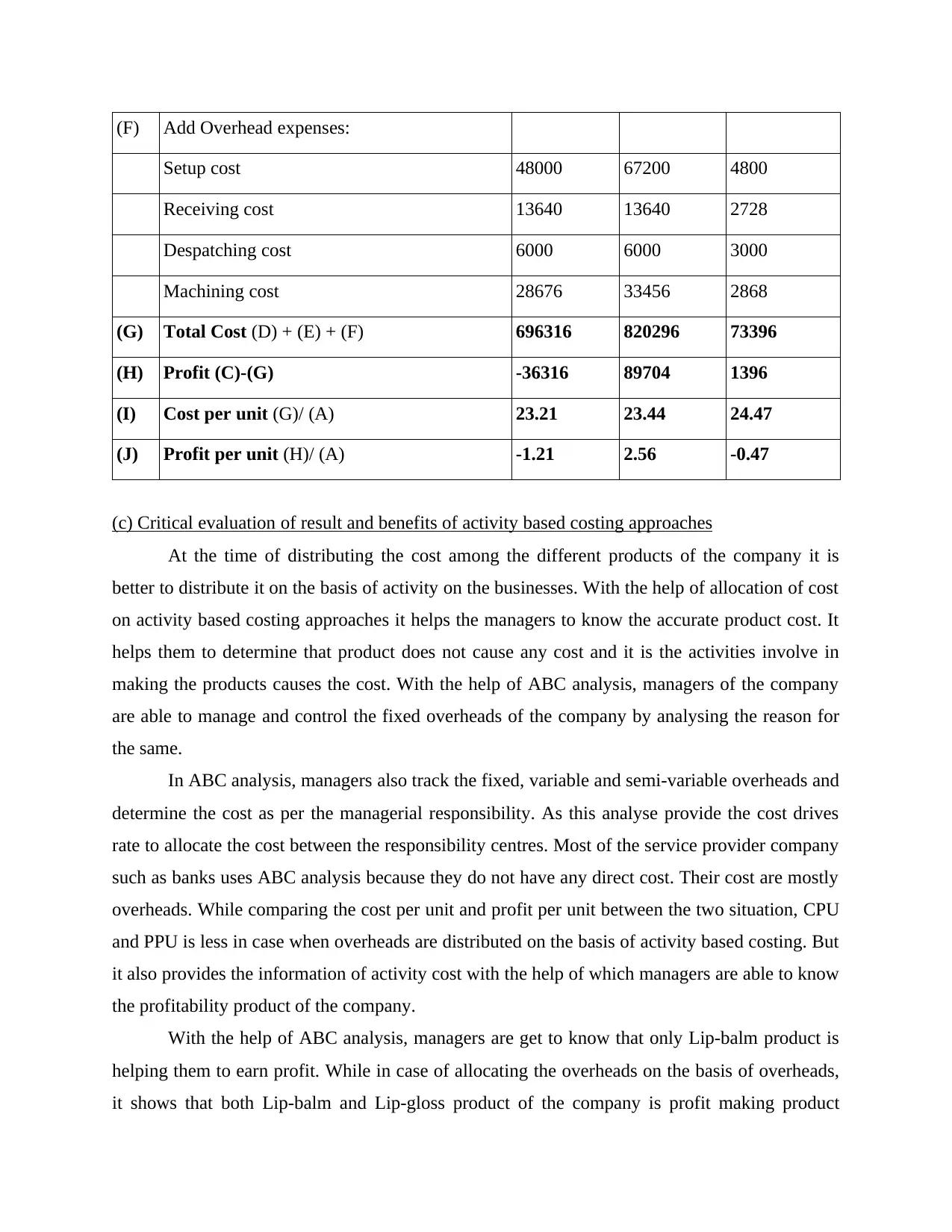
(F) Add Overhead expenses:
Setup cost 48000 67200 4800
Receiving cost 13640 13640 2728
Despatching cost 6000 6000 3000
Machining cost 28676 33456 2868
(G) Total Cost (D) + (E) + (F) 696316 820296 73396
(H) Profit (C)-(G) -36316 89704 1396
(I) Cost per unit (G)/ (A) 23.21 23.44 24.47
(J) Profit per unit (H)/ (A) -1.21 2.56 -0.47
(c) Critical evaluation of result and benefits of activity based costing approaches
At the time of distributing the cost among the different products of the company it is
better to distribute it on the basis of activity on the businesses. With the help of allocation of cost
on activity based costing approaches it helps the managers to know the accurate product cost. It
helps them to determine that product does not cause any cost and it is the activities involve in
making the products causes the cost. With the help of ABC analysis, managers of the company
are able to manage and control the fixed overheads of the company by analysing the reason for
the same.
In ABC analysis, managers also track the fixed, variable and semi-variable overheads and
determine the cost as per the managerial responsibility. As this analyse provide the cost drives
rate to allocate the cost between the responsibility centres. Most of the service provider company
such as banks uses ABC analysis because they do not have any direct cost. Their cost are mostly
overheads. While comparing the cost per unit and profit per unit between the two situation, CPU
and PPU is less in case when overheads are distributed on the basis of activity based costing. But
it also provides the information of activity cost with the help of which managers are able to know
the profitability product of the company.
With the help of ABC analysis, managers are get to know that only Lip-balm product is
helping them to earn profit. While in case of allocating the overheads on the basis of overheads,
it shows that both Lip-balm and Lip-gloss product of the company is profit making product
Setup cost 48000 67200 4800
Receiving cost 13640 13640 2728
Despatching cost 6000 6000 3000
Machining cost 28676 33456 2868
(G) Total Cost (D) + (E) + (F) 696316 820296 73396
(H) Profit (C)-(G) -36316 89704 1396
(I) Cost per unit (G)/ (A) 23.21 23.44 24.47
(J) Profit per unit (H)/ (A) -1.21 2.56 -0.47
(c) Critical evaluation of result and benefits of activity based costing approaches
At the time of distributing the cost among the different products of the company it is
better to distribute it on the basis of activity on the businesses. With the help of allocation of cost
on activity based costing approaches it helps the managers to know the accurate product cost. It
helps them to determine that product does not cause any cost and it is the activities involve in
making the products causes the cost. With the help of ABC analysis, managers of the company
are able to manage and control the fixed overheads of the company by analysing the reason for
the same.
In ABC analysis, managers also track the fixed, variable and semi-variable overheads and
determine the cost as per the managerial responsibility. As this analyse provide the cost drives
rate to allocate the cost between the responsibility centres. Most of the service provider company
such as banks uses ABC analysis because they do not have any direct cost. Their cost are mostly
overheads. While comparing the cost per unit and profit per unit between the two situation, CPU
and PPU is less in case when overheads are distributed on the basis of activity based costing. But
it also provides the information of activity cost with the help of which managers are able to know
the profitability product of the company.
With the help of ABC analysis, managers are get to know that only Lip-balm product is
helping them to earn profit. While in case of allocating the overheads on the basis of overheads,
it shows that both Lip-balm and Lip-gloss product of the company is profit making product
Paraphrase This Document
Need a fresh take? Get an instant paraphrase of this document with our AI Paraphraser
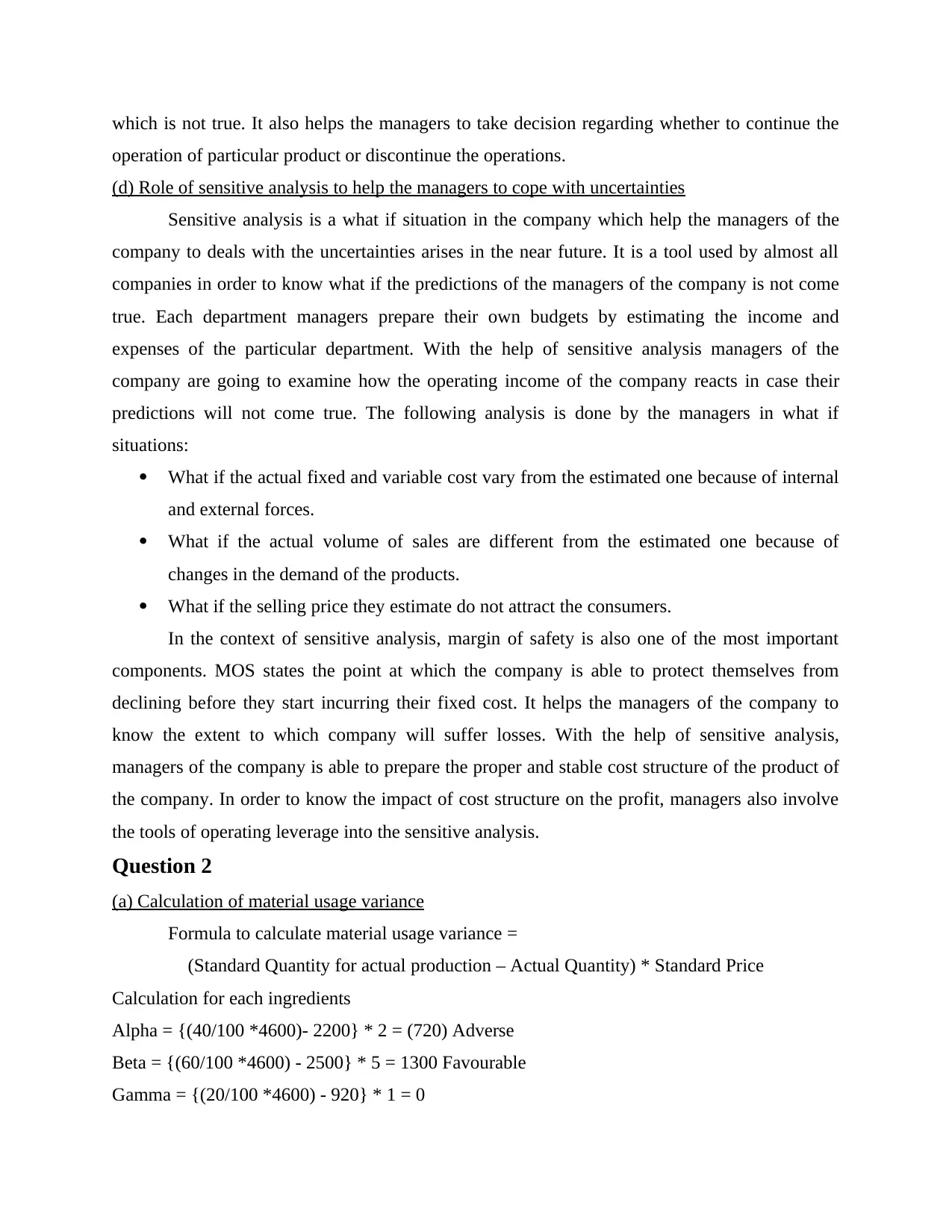
which is not true. It also helps the managers to take decision regarding whether to continue the
operation of particular product or discontinue the operations.
(d) Role of sensitive analysis to help the managers to cope with uncertainties
Sensitive analysis is a what if situation in the company which help the managers of the
company to deals with the uncertainties arises in the near future. It is a tool used by almost all
companies in order to know what if the predictions of the managers of the company is not come
true. Each department managers prepare their own budgets by estimating the income and
expenses of the particular department. With the help of sensitive analysis managers of the
company are going to examine how the operating income of the company reacts in case their
predictions will not come true. The following analysis is done by the managers in what if
situations:
What if the actual fixed and variable cost vary from the estimated one because of internal
and external forces.
What if the actual volume of sales are different from the estimated one because of
changes in the demand of the products.
What if the selling price they estimate do not attract the consumers.
In the context of sensitive analysis, margin of safety is also one of the most important
components. MOS states the point at which the company is able to protect themselves from
declining before they start incurring their fixed cost. It helps the managers of the company to
know the extent to which company will suffer losses. With the help of sensitive analysis,
managers of the company is able to prepare the proper and stable cost structure of the product of
the company. In order to know the impact of cost structure on the profit, managers also involve
the tools of operating leverage into the sensitive analysis.
Question 2
(a) Calculation of material usage variance
Formula to calculate material usage variance =
(Standard Quantity for actual production – Actual Quantity) * Standard Price
Calculation for each ingredients
Alpha = {(40/100 *4600)- 2200} * 2 = (720) Adverse
Beta = {(60/100 *4600) - 2500} * 5 = 1300 Favourable
Gamma = {(20/100 *4600) - 920} * 1 = 0
operation of particular product or discontinue the operations.
(d) Role of sensitive analysis to help the managers to cope with uncertainties
Sensitive analysis is a what if situation in the company which help the managers of the
company to deals with the uncertainties arises in the near future. It is a tool used by almost all
companies in order to know what if the predictions of the managers of the company is not come
true. Each department managers prepare their own budgets by estimating the income and
expenses of the particular department. With the help of sensitive analysis managers of the
company are going to examine how the operating income of the company reacts in case their
predictions will not come true. The following analysis is done by the managers in what if
situations:
What if the actual fixed and variable cost vary from the estimated one because of internal
and external forces.
What if the actual volume of sales are different from the estimated one because of
changes in the demand of the products.
What if the selling price they estimate do not attract the consumers.
In the context of sensitive analysis, margin of safety is also one of the most important
components. MOS states the point at which the company is able to protect themselves from
declining before they start incurring their fixed cost. It helps the managers of the company to
know the extent to which company will suffer losses. With the help of sensitive analysis,
managers of the company is able to prepare the proper and stable cost structure of the product of
the company. In order to know the impact of cost structure on the profit, managers also involve
the tools of operating leverage into the sensitive analysis.
Question 2
(a) Calculation of material usage variance
Formula to calculate material usage variance =
(Standard Quantity for actual production – Actual Quantity) * Standard Price
Calculation for each ingredients
Alpha = {(40/100 *4600)- 2200} * 2 = (720) Adverse
Beta = {(60/100 *4600) - 2500} * 5 = 1300 Favourable
Gamma = {(20/100 *4600) - 920} * 1 = 0
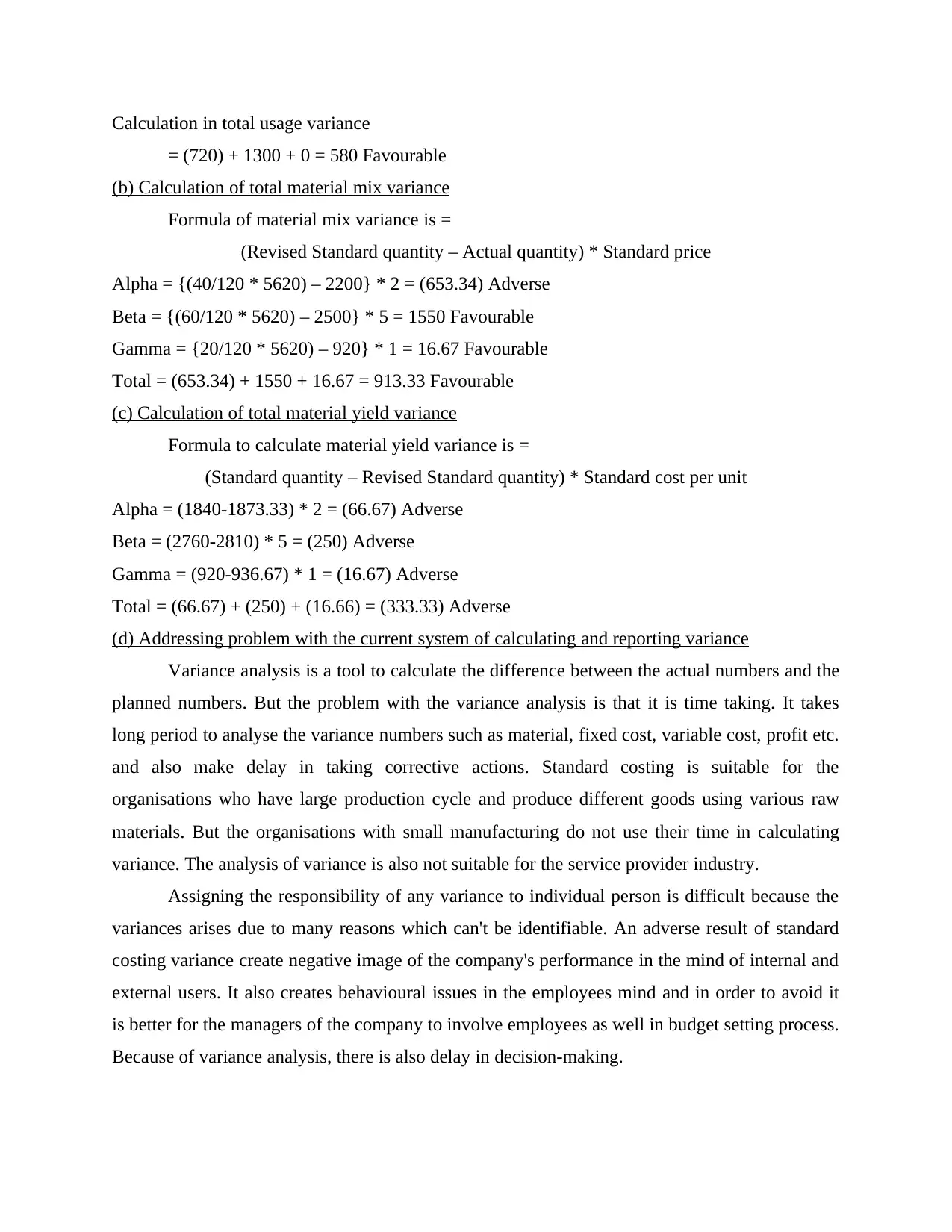
Calculation in total usage variance
= (720) + 1300 + 0 = 580 Favourable
(b) Calculation of total material mix variance
Formula of material mix variance is =
(Revised Standard quantity – Actual quantity) * Standard price
Alpha = {(40/120 * 5620) – 2200} * 2 = (653.34) Adverse
Beta = {(60/120 * 5620) – 2500} * 5 = 1550 Favourable
Gamma = {20/120 * 5620) – 920} * 1 = 16.67 Favourable
Total = (653.34) + 1550 + 16.67 = 913.33 Favourable
(c) Calculation of total material yield variance
Formula to calculate material yield variance is =
(Standard quantity – Revised Standard quantity) * Standard cost per unit
Alpha = (1840-1873.33) * 2 = (66.67) Adverse
Beta = (2760-2810) * 5 = (250) Adverse
Gamma = (920-936.67) * 1 = (16.67) Adverse
Total = (66.67) + (250) + (16.66) = (333.33) Adverse
(d) Addressing problem with the current system of calculating and reporting variance
Variance analysis is a tool to calculate the difference between the actual numbers and the
planned numbers. But the problem with the variance analysis is that it is time taking. It takes
long period to analyse the variance numbers such as material, fixed cost, variable cost, profit etc.
and also make delay in taking corrective actions. Standard costing is suitable for the
organisations who have large production cycle and produce different goods using various raw
materials. But the organisations with small manufacturing do not use their time in calculating
variance. The analysis of variance is also not suitable for the service provider industry.
Assigning the responsibility of any variance to individual person is difficult because the
variances arises due to many reasons which can't be identifiable. An adverse result of standard
costing variance create negative image of the company's performance in the mind of internal and
external users. It also creates behavioural issues in the employees mind and in order to avoid it
is better for the managers of the company to involve employees as well in budget setting process.
Because of variance analysis, there is also delay in decision-making.
= (720) + 1300 + 0 = 580 Favourable
(b) Calculation of total material mix variance
Formula of material mix variance is =
(Revised Standard quantity – Actual quantity) * Standard price
Alpha = {(40/120 * 5620) – 2200} * 2 = (653.34) Adverse
Beta = {(60/120 * 5620) – 2500} * 5 = 1550 Favourable
Gamma = {20/120 * 5620) – 920} * 1 = 16.67 Favourable
Total = (653.34) + 1550 + 16.67 = 913.33 Favourable
(c) Calculation of total material yield variance
Formula to calculate material yield variance is =
(Standard quantity – Revised Standard quantity) * Standard cost per unit
Alpha = (1840-1873.33) * 2 = (66.67) Adverse
Beta = (2760-2810) * 5 = (250) Adverse
Gamma = (920-936.67) * 1 = (16.67) Adverse
Total = (66.67) + (250) + (16.66) = (333.33) Adverse
(d) Addressing problem with the current system of calculating and reporting variance
Variance analysis is a tool to calculate the difference between the actual numbers and the
planned numbers. But the problem with the variance analysis is that it is time taking. It takes
long period to analyse the variance numbers such as material, fixed cost, variable cost, profit etc.
and also make delay in taking corrective actions. Standard costing is suitable for the
organisations who have large production cycle and produce different goods using various raw
materials. But the organisations with small manufacturing do not use their time in calculating
variance. The analysis of variance is also not suitable for the service provider industry.
Assigning the responsibility of any variance to individual person is difficult because the
variances arises due to many reasons which can't be identifiable. An adverse result of standard
costing variance create negative image of the company's performance in the mind of internal and
external users. It also creates behavioural issues in the employees mind and in order to avoid it
is better for the managers of the company to involve employees as well in budget setting process.
Because of variance analysis, there is also delay in decision-making.
⊘ This is a preview!⊘
Do you want full access?
Subscribe today to unlock all pages.

Trusted by 1+ million students worldwide

Question 3
Budgeting is an important component of management control system, as it provides a
systematic planning, coordination and control for management. There are two main methods of
budgeting which includes Incremental budgeting and Zero based budgeting.
— Incremental Budgeting
It is the traditional budgeting method in which the budget is prepared by taking the
current duration's budget into consideration or actual performance as a base, with incremental
amounts being added for the new budget period. The incremental amounts include adjustment in
inflation rates, and planned increases in sales prices and costs. There are various benefits of this
method such as it is easy to prepare and is therefore fast to create, as it is being easy to prepare
then also easy to understand, requires less preparation time which leads to less preparation cost
and also helps to prevent conflicts between departmental managers since a consistent approach is
adopted throughout the organization (Henrydoss, 2017).
However, there are various drawbacks also of this particular method which includes that
this method assumes hypothetically all current activities and costs which are still needed, even
without examining the situations in detail. This method promotes unnecessary spendings for a
company. This type of budgeting may discourage the production of innovative ideas and growth
within the employees of the organization. Incremental budgeting method adopts conservative
business environment. The budgets prepared with this method are generally not responsive to
potential changes that can result from unforeseen factors. The stability of incremental budgets
does not provide any incentives to the company management for reviewing the budget with a
view to realize savings in expenditures.
— Zero-based Budgeting
This method includes preparation of budgeting from the scratch with a zero base. It
involves re-evaluation of items of cash flow statement and justifying the expenditures that is to
be incurred by the department within the organization (Ibrahim, 2019). Zero base budgeting
includes various steps which includes identification of tasks, then finding ways and means of
completing the tasks, evaluating the solutions along with searching the alternatives of sources of
Budgeting is an important component of management control system, as it provides a
systematic planning, coordination and control for management. There are two main methods of
budgeting which includes Incremental budgeting and Zero based budgeting.
— Incremental Budgeting
It is the traditional budgeting method in which the budget is prepared by taking the
current duration's budget into consideration or actual performance as a base, with incremental
amounts being added for the new budget period. The incremental amounts include adjustment in
inflation rates, and planned increases in sales prices and costs. There are various benefits of this
method such as it is easy to prepare and is therefore fast to create, as it is being easy to prepare
then also easy to understand, requires less preparation time which leads to less preparation cost
and also helps to prevent conflicts between departmental managers since a consistent approach is
adopted throughout the organization (Henrydoss, 2017).
However, there are various drawbacks also of this particular method which includes that
this method assumes hypothetically all current activities and costs which are still needed, even
without examining the situations in detail. This method promotes unnecessary spendings for a
company. This type of budgeting may discourage the production of innovative ideas and growth
within the employees of the organization. Incremental budgeting method adopts conservative
business environment. The budgets prepared with this method are generally not responsive to
potential changes that can result from unforeseen factors. The stability of incremental budgets
does not provide any incentives to the company management for reviewing the budget with a
view to realize savings in expenditures.
— Zero-based Budgeting
This method includes preparation of budgeting from the scratch with a zero base. It
involves re-evaluation of items of cash flow statement and justifying the expenditures that is to
be incurred by the department within the organization (Ibrahim, 2019). Zero base budgeting
includes various steps which includes identification of tasks, then finding ways and means of
completing the tasks, evaluating the solutions along with searching the alternatives of sources of
Paraphrase This Document
Need a fresh take? Get an instant paraphrase of this document with our AI Paraphraser
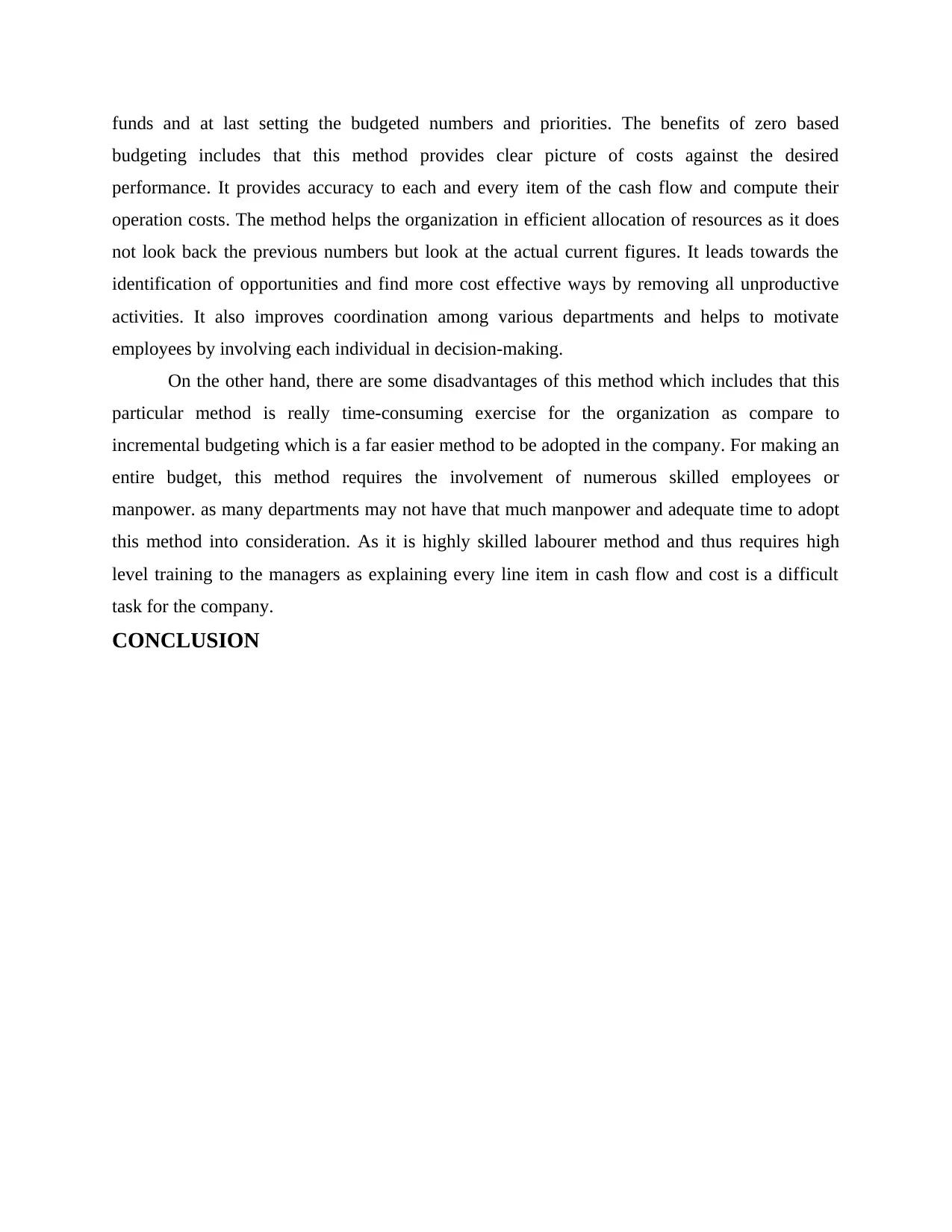
funds and at last setting the budgeted numbers and priorities. The benefits of zero based
budgeting includes that this method provides clear picture of costs against the desired
performance. It provides accuracy to each and every item of the cash flow and compute their
operation costs. The method helps the organization in efficient allocation of resources as it does
not look back the previous numbers but look at the actual current figures. It leads towards the
identification of opportunities and find more cost effective ways by removing all unproductive
activities. It also improves coordination among various departments and helps to motivate
employees by involving each individual in decision-making.
On the other hand, there are some disadvantages of this method which includes that this
particular method is really time-consuming exercise for the organization as compare to
incremental budgeting which is a far easier method to be adopted in the company. For making an
entire budget, this method requires the involvement of numerous skilled employees or
manpower. as many departments may not have that much manpower and adequate time to adopt
this method into consideration. As it is highly skilled labourer method and thus requires high
level training to the managers as explaining every line item in cash flow and cost is a difficult
task for the company.
CONCLUSION
budgeting includes that this method provides clear picture of costs against the desired
performance. It provides accuracy to each and every item of the cash flow and compute their
operation costs. The method helps the organization in efficient allocation of resources as it does
not look back the previous numbers but look at the actual current figures. It leads towards the
identification of opportunities and find more cost effective ways by removing all unproductive
activities. It also improves coordination among various departments and helps to motivate
employees by involving each individual in decision-making.
On the other hand, there are some disadvantages of this method which includes that this
particular method is really time-consuming exercise for the organization as compare to
incremental budgeting which is a far easier method to be adopted in the company. For making an
entire budget, this method requires the involvement of numerous skilled employees or
manpower. as many departments may not have that much manpower and adequate time to adopt
this method into consideration. As it is highly skilled labourer method and thus requires high
level training to the managers as explaining every line item in cash flow and cost is a difficult
task for the company.
CONCLUSION

REFERENCES
Books and journals
Wegmann, G., 2019. A typology of cost accounting practices based on Activity-Based Costing-a
strategic cost management approach. Asia-Pacific Management Accounting
Journal. 14. pp.161-184.
Sangiumvibool, P. and Chonglerttham, S., 2017. Performance-based budgeting for continuing
and lifelong education services: the Thai higher education perspective. Journal of
Higher Education Policy and Management. 39(1). pp.58-74.
Kamiński, B., Jakubczyk, M. and Szufel, P., 2018. A framework for sensitivity analysis of
decision trees. Central European journal of operations research. 26(1). pp.135-159.
Delgarm, N. and et.al., 2018. Sensitivity analysis of building energy performance: A simulation-
based approach using OFAT and variance-based sensitivity analysis
methods. Journal of Building Engineering. 15. pp.181-193.
Marzlin Marzuki, N. A. R. and Ismail, J., 2019. Benefits and limitations of variance analysis in
management accounting. ACCOUNTING BULLETIN. p.15.
Apunda, M. A. and Ndede, F. W., 2020. The effect of adoption of management accounting
practices on financial performance of commercial parastatals in Kenya. International
Academic Journal of Economics and Finance. 3(6). pp.119-130.
Oyewo, B., Ajibolade, S. and Obazee, A., 2019. The influence of stakeholders on management
accounting practice. Journal of Sustainable Finance & Investment. 9(4). pp.295-324.
Ibrahim, M. M., 2019. Designing zero-based budgeting for public organizations. Problems and
Perspectives in Management. 17(2).
Pavlik, A., 2020. Familiarize yourself with budgeting best practices to boost your department's
success. Student Affairs Today. 22(12). pp.6-7.
Online
Financial Performance Management. 2021 [Online]. Available
through:<https://www.silvon.com/financial-performance.php>
1
Books and journals
Wegmann, G., 2019. A typology of cost accounting practices based on Activity-Based Costing-a
strategic cost management approach. Asia-Pacific Management Accounting
Journal. 14. pp.161-184.
Sangiumvibool, P. and Chonglerttham, S., 2017. Performance-based budgeting for continuing
and lifelong education services: the Thai higher education perspective. Journal of
Higher Education Policy and Management. 39(1). pp.58-74.
Kamiński, B., Jakubczyk, M. and Szufel, P., 2018. A framework for sensitivity analysis of
decision trees. Central European journal of operations research. 26(1). pp.135-159.
Delgarm, N. and et.al., 2018. Sensitivity analysis of building energy performance: A simulation-
based approach using OFAT and variance-based sensitivity analysis
methods. Journal of Building Engineering. 15. pp.181-193.
Marzlin Marzuki, N. A. R. and Ismail, J., 2019. Benefits and limitations of variance analysis in
management accounting. ACCOUNTING BULLETIN. p.15.
Apunda, M. A. and Ndede, F. W., 2020. The effect of adoption of management accounting
practices on financial performance of commercial parastatals in Kenya. International
Academic Journal of Economics and Finance. 3(6). pp.119-130.
Oyewo, B., Ajibolade, S. and Obazee, A., 2019. The influence of stakeholders on management
accounting practice. Journal of Sustainable Finance & Investment. 9(4). pp.295-324.
Ibrahim, M. M., 2019. Designing zero-based budgeting for public organizations. Problems and
Perspectives in Management. 17(2).
Pavlik, A., 2020. Familiarize yourself with budgeting best practices to boost your department's
success. Student Affairs Today. 22(12). pp.6-7.
Online
Financial Performance Management. 2021 [Online]. Available
through:<https://www.silvon.com/financial-performance.php>
1
⊘ This is a preview!⊘
Do you want full access?
Subscribe today to unlock all pages.

Trusted by 1+ million students worldwide

Financial Performance
Management
[Online]. Available through:<>
2
Management
[Online]. Available through:<>
2
1 out of 10
Related Documents
Your All-in-One AI-Powered Toolkit for Academic Success.
+13062052269
info@desklib.com
Available 24*7 on WhatsApp / Email
![[object Object]](/_next/static/media/star-bottom.7253800d.svg)
Unlock your academic potential
Copyright © 2020–2025 A2Z Services. All Rights Reserved. Developed and managed by ZUCOL.





